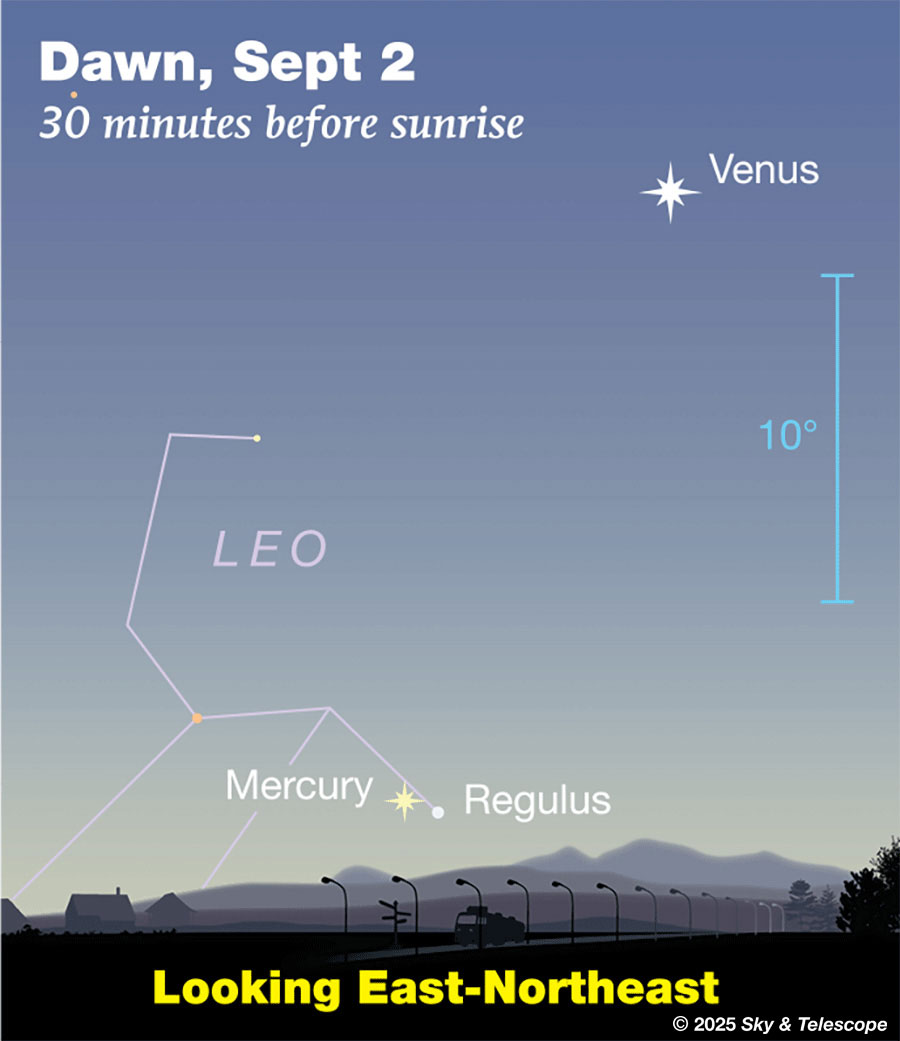Special to CosmicTribune.com, September 1, 2025
Excerpts from weekly Sky&Telescope report.
SUNDAY, AUGUST 31
■ Now Antares and Delta Scorpii line up to the right of the Moon. The line points the same length the other way from the Moon to the spout of the Sagittarius Teapot.
MONDAY, SEPTEMBER 1
■ September’s arrival means that Scorpius, that proud standout of the southern sky in July, is now tilting over and lying down in the southwest, preparing to bed down and drift off for the season.
 Mercury is in conjunction with much fainter Regulus very low in bright dawn Tuesday morning. You’ll need a flat horizon and optical aid. At least Venus helps guide the way. Good luck. Regulus is currently just one tenth as bright as Mercury. In other words, it’s 2.5 magnitudes fainter.
Mercury is in conjunction with much fainter Regulus very low in bright dawn Tuesday morning. You’ll need a flat horizon and optical aid. At least Venus helps guide the way. Good luck. Regulus is currently just one tenth as bright as Mercury. In other words, it’s 2.5 magnitudes fainter.
TUESDAY, SEPTEMBER 2
■ Now the Moon resides in or near the Teapot’s handle. Covering the Moon with your fingertip helps reveal stars near it.
■ If you live in the world’s mid-northern latitudes, look for bright Vega passing your zenith as twilight fades away now. Vega goes right through your zenith if you’re at latitude 39° north: near Baltimore, Kansas City, Lake Tahoe, Sendai, Beijing, Ankara, Athens, Lisbon.
WEDNESDAY, SEPTEMBER 3
■ Titan, Saturn’s largest moon, casts its shadow onto Saturn’s face tonight. Every 15 years, around the time we see Saturn’s rings edge on, Titan repeatedly crosses in front of Saturn from Earth’s viewpoint — and, more visibly, casts its very tiny black shadow onto the planet. The current series of these events is nearing its end.
Tonight Titan’s shadow transits the planet’s high northern latitudes from 5:25 to 8:50 UT September 4th (UT date). In EDT that’s tonight from 1:25 a.m. to 4:50 a.m. In PDT it’s from 10:25 p.m. to 1:50 a.m.
Wherever you are Saturn is up almost all night now, though it’s highest in the steadiest atmospheric seeing after midnight. So all of North and Central America again gets a chance at this event.
But if you’re used to seeing shadows of Jupiter’s moons on Jupiter, be warned: Saturn is twice as far away, and although Titan is large, it’s not twice as large as Jupiter’s moons.
THURSDAY, SEPTEMBER 4
■ How soon after sunset can you see the big Summer Triangle? As the very first stars come out. Vega, the Triangle’s brightest star, is nearly at the zenith (for skywatchers at mid-northern latitudes). The next-brightest star of the Triangle is Altair, high in the southeast. Hint: The Moon this evening hangs lower in the southeast at dusk. Look for Altair halfway between it and Vega.
The last of the three Summer Triangle stars is Deneb, two fists east of Vega.
After dark, of course, they stand out prominently. I can even see them from downtown Boston. As night grows late the Triangle slides toward the west, a preview of what it will do in early evening through the fall.
FRIDAY, SEPTEMBER 5
■ The waxing gibbous Moon shines in the south-southeast this evening, on a line between Altair and Fomalhaut. Altair is the bright star three or four fists above the Moon and maybe somewhat to the right. Fomalhaut, the Autumn Star, rises a little after dark depending on your latitude.
Imagine a line from Altair down through the Moon and continuing on. The line will hit either Fomalhaut or the place on your horizon to watch for Fomalhaut to rise.
SATURDAY, SEPTEMBER 6
■ The bright Moon early this evening forms an isosceles triangle (two equal sides) with Saturn to its lower left and Fomalhaut the same distance down to its lower right. At the night advances, the triangle climbs higher while turning clockwise.
SUNDAY, SEPTEMBER 7
■ Full Moon (exactly full at 2:09 p.m. EDT). Saturn follows about 8° or 10° behind it across the sky tonight. Saturn is just two weeks from its own opposition.
■ With your naked eyes, what is the smallest surface feature that you can see on the Moon? Test your vision with the Lunar Eye Chart on pages 52 and 53 of the September Sky & Telescope. The 12 increasingly difficult test markings were worked out more than a century ago by Harvard astronomer W. H. Pickering.
■ A total eclipse of the Moon will occur for easternmost Africa, most of the Middle East and Asia, and the western half of Australia.

You must be logged in to post a comment Login